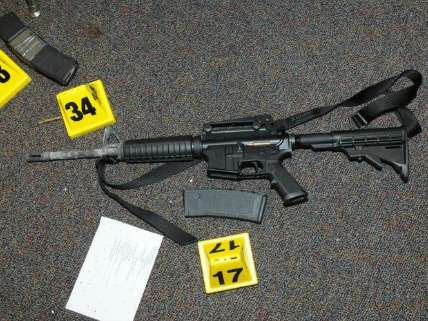The New York Times Admits 'Assault Weapons' Are Not 'High-Powered'
But not for long, I bet.

In a brief, illustrated history of the AK-47 and the AR-15, New York Times reporter C.J. Chivers twice notes that they are "medium-powered" rifles, meaning they fire cartridges of intermediate size. So do semiautomatic versions of those guns, dubbed "modern sporting rifles" by people trying to sell them and "assault weapons" by people trying to ban them. Yet Chivers' colleagues at the Times, including fellow reporters as well as members of the editorial board, routinely claim these guns are "high-powered," which sounds scarier and makes it seem as if politicians focus on these weapons for rational reasons. Some examples from the last few years, beginning with the push for new gun controls that followed the 2012 massacre at Sandy Hook Elementary School in Newtown, Connecticut:
Broad Gun Control Efforts Introduced in Wake of Shooting (news story, December 18, 2012)
"A private equity company announced that it would sell off the company that made the high-powered assault rifle used in the Newtown shootings last week."
When the Mentally Ill Own Guns (editorial, December 28, 2013)
"The common denominator in gun violence…is not deranged individuals; it is the easy access to assault rifles and other high-powered weapons afforded all Americans."
A Deadline for Grandfathered Weapons (editorial, April 15, 2014)
"Failure to register one of these high-powered weapons [covered by New York's expanded "assault weapon" ban] would, in most cases, make it an illegal firearm."
How an Effort to Close Loopholes in California's Assault Weapons Law Was Thwarted (news story, December 7, 2015)
"It is primarily concern about high-powered weapons that flares after mass attacks like those in the last two weeks, in San Bernardino and in Colorado Springs."
The Shock of Ordinary Gun Violence (editorial, May 26, 2016)
"A timid Congress cowed by the gun lobby fails to enact stronger gun-control laws for a nation increasingly flooded with high-powered weapons."
Orlando Shooting Reignites Gun Control Debate in Congress (news story, June 14, 2016)
"The nonprofit Brady Campaign to Prevent Gun Violence renewed its call to impose tougher restrictions on the sales of high-powered rifles and other firearms."
"The fact that Mr. Mateen [the perpetrator of the Orlando massacre] had come to the attention of the authorities and was still permitted to buy high-powered weapons presented a remarkably different set of circumstances from previous attacks by lone gunmen previously unknown to the police."
Specter of 1994 Assault Weapons Ban Lingers Over New Gun Control Push (news story, June 20, 2016)
"Many types of high-powered weapons fell outside the ban, including knockoffs, older versions and altered rifles that filled the void."
There are other examples, going back to the period when California enacted the first "assault weapon" ban in the late 1980s. The incorrect terminology is not some minor technical error, because it goes directly to the question of whether bans on so-called assault weapons make any kind of sense. Every time a reporter or editorialist says such laws are aimed at "high-powered" guns, he falsely implies that the rounds fired by "assault weapons" are especially large or have especially high muzzle energy (partly a function of caliber), making them especially deadly. But that is not true, and the definitions of "assault weapon" written by legislators do not refer to caliber or muzzle energy at all. The New York Times has been committing this "error" for decades, and at a certain point you have to wonder whether that's the correct term for it.


Show Comments (101)